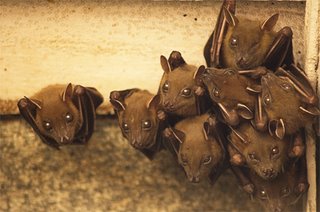PS: I'm at home in Bombay. To call my internet access here bad is to compliment it. Posting will be a bit slow for a while.
 Have you ever watched a Bonnet Macaque and felt that it was extremely expressive? It indeed is. Macaques use a huge range of facial gestures to communicate within and between their social groups. Each gesture has a subtle meaning that indicates different degrees of submissive to aggressive behaviour, to simple greeting and play behaviour. Simple things like lip-smacks (submission) and eye-flashes (greeting) lubricate everyday living. Presenting, a display of the bottom, unlike in humans, is almost a gesture of humility, at any rate, submission. And yet, even high ranked males will occasionally present to lower ranked monkeys, perhaps to keep their loyalty, to keep everyone happy. Adult males, females and younger members will groom others (allogrooming) to ingratiate themselves to the groomee. When members of another troop come too close, a strategic yawn will display the majestic canines of the alpha male, providing an oh-so-subtle indicator of discomfort.
Have you ever watched a Bonnet Macaque and felt that it was extremely expressive? It indeed is. Macaques use a huge range of facial gestures to communicate within and between their social groups. Each gesture has a subtle meaning that indicates different degrees of submissive to aggressive behaviour, to simple greeting and play behaviour. Simple things like lip-smacks (submission) and eye-flashes (greeting) lubricate everyday living. Presenting, a display of the bottom, unlike in humans, is almost a gesture of humility, at any rate, submission. And yet, even high ranked males will occasionally present to lower ranked monkeys, perhaps to keep their loyalty, to keep everyone happy. Adult males, females and younger members will groom others (allogrooming) to ingratiate themselves to the groomee. When members of another troop come too close, a strategic yawn will display the majestic canines of the alpha male, providing an oh-so-subtle indicator of discomfort. Behaviours are also used to indicate heirarchy, each animal's knowledge of its position within that ladder and subtle shifts that occur. A young male will present often to an older, higher ranked male, until one day it begins an alliance with another and reaches upward on the social ladder. Females are born into their positions on this ladder in Bonnet macaque societies, and cannot climb or descend. Almost tailor made for these trapped females, Bonnets have a separate ranking system one that measures social attractiveness. Females may have a low social rank, but be quite comely in other ways. Socially attractive females in certain interactions actually precede higher ranked females.
Behaviours are also used to indicate heirarchy, each animal's knowledge of its position within that ladder and subtle shifts that occur. A young male will present often to an older, higher ranked male, until one day it begins an alliance with another and reaches upward on the social ladder. Females are born into their positions on this ladder in Bonnet macaque societies, and cannot climb or descend. Almost tailor made for these trapped females, Bonnets have a separate ranking system one that measures social attractiveness. Females may have a low social rank, but be quite comely in other ways. Socially attractive females in certain interactions actually precede higher ranked females. If you think about it that's a lot to keep in mind. Social heirarchies and networks will jostle for brain-space with food and water maps, spatial maps, cultural memories, and off course all the other hard-wired stuff. The boundaries and details of these social interactions will shift continuously, new players may emerge, old ones disappear. The representations of this complex system in the brain must constantly be rewired. It must remain flexible and capable of learning through an entire macaque life.
If you think about it that's a lot to keep in mind. Social heirarchies and networks will jostle for brain-space with food and water maps, spatial maps, cultural memories, and off course all the other hard-wired stuff. The boundaries and details of these social interactions will shift continuously, new players may emerge, old ones disappear. The representations of this complex system in the brain must constantly be rewired. It must remain flexible and capable of learning through an entire macaque life.Anindya Sinha from NIAS, among others, has argued that this may be the route through which we humans, primates as well, have reached our extravagantly complex and conscious brains. He argues in yet another paper, that many complex mental states such as deception, intentionality and attribution may be seen in even 'primitive' primates like the Bonnet. The idea I suppose is that somewhere along the primate lineage the two process ran away with each other, complex and intelligent brains fueled the growth of more elaborate social and communication structures and vice versa.
An elegant idea, and testable! The more social an animal is the more likely it is to be intelligent. Even now, if one thinks about all the animals that are attributed with intelligence whether merely through folklore or through actual research, many are indeed social. Dolphins, apes, elephants, corvids are the first to come to mind, each with complex sometimes unexplored social systems.













